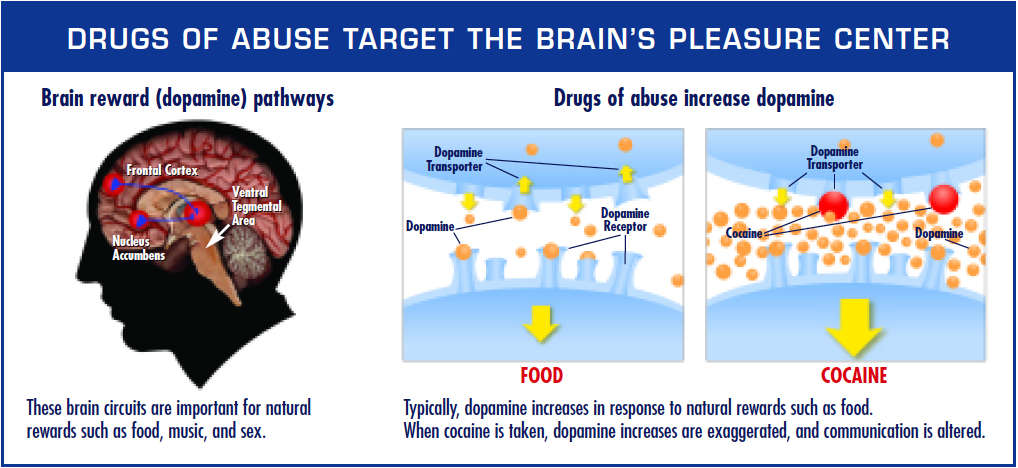Paul’s Health Part B: Drug Addiction
Over The Next Few Years
- Paul was often agitated, sweating, complaining of back pain
- Self-medicating with alcohol and prescription drugs
- Long-term disability
- Return to work program
- Taking mother-in-law’s post-op medications
- Denied having a “pill problem”
- Stated he was feeling overwhelmed with everything going on in his life
What is drug addiction?
- Initial decision to take drugs is voluntary.
- Repeated drug use can lead to brain changes that challenge self-control & resist urges.
- Addictive drugs provide a shortcut to the brain’s reward centre.
- Repeated drug use overwhelms receptor cells.
- The natural capacity to produce dopamine in the reward centre is reduced.
- Addicts may require higher doses and quicker passage into the brain.

The Brain’s Reward System

Addictive drugs provide a shortcut to the brain’s reward system by flooding the nucleus accumbens with dopamine.
The hippocampus lays down memories of this rapid sense of satisfaction, and the amygdala creates a conditioned response to certain stimuli.
The reward system may be more vulnerable, responses to stress more intense, or the formation of addictive habits quicker in some people, especially those suffering from depression, anxiety, or schizophrenia, and those with disorders like antisocial and borderline

Why?
Biology
- Genes account for about half of a person’s risk for addiction
- Gender, ethnicity, and presence of other mental disorders
Environment
- Family & friends
- Economic status & general quality of life
- Peer pressure, physical & sexual abuse
- Early exposure to drugs, stress, and parental guidance
Development
- Genetic & environmental factors interact with critical developmental stages
- The earlier drug use begins, the more likely to become addicted
- Teens’ brains are still developing (decision-making, judgment, and self-control)
Substance Detection
Routine Methods
- Vitros analyzer slide
- Assay specific for ethanol (alcohol, most commonly detected toxic substance in emergency rooms) – DOES NOT detect methanol (windshield washer fluid)
- Positive bias in the presence of ethylene glycol (anti-freeze) or isopropanol (rubbing alcohol)
Gas Chromatography
- Preferred method for detecting and quantifying volatiles (alcohols)
- Simultaneously measures ethanol, methanol, and isopropanol
- Reference substance (internal standard) → N-propanol
Q&A
What volatile would Paul have tested positive for?
Ethanol due to his alcohol consumption
Paul’s relapse
Before Paul’s recent relapse, he worked odd jobs, but struggled to pay the bills and manage his cocaine habit. Paul’s parents wanted nothing to do with him. His first wife left him in 2008, taking their adopted twin girls with her. This seemed to be the wake-up call Paul needed to get his life in order. He joined Narcotics Anonymous in 2009. When Paul relapsed in 2018, Nancy called Paul’s old NA sponsor for suggestions on what to do. Paul was angry at the world, blaming everyone else for how his life turned out.
Overcoming Paul’s Drug Addiction
- Recognize you have a problem
- Decide to make a change
Committing to sobriety involves changing:
- The way you deal with stress
- Who you allow in your life
- What you do in your free time
- How you think about yourself
- The prescription and over-the-counter medications you take
Treatment options:
- Detoxification
- Behavioral counseling
- Medication
- Long-term follow-up

